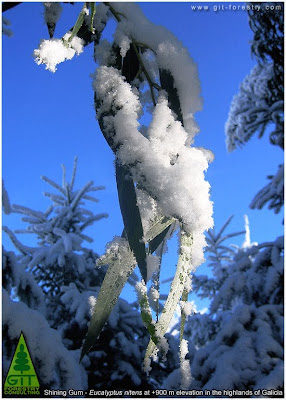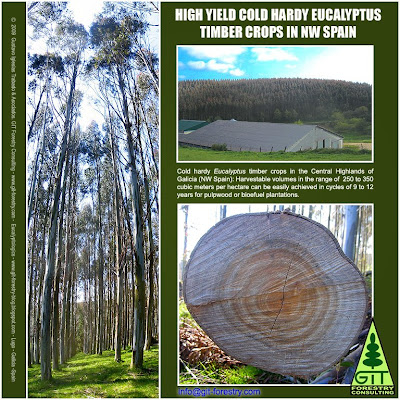Eucalyptus and Snow: More winter views of eucalypt timber plantations in Northwestern Spain
Gustavo Iglesias Trabado 
GIT Forestry Consulting SL - Consultoría y Servicios de Ingeniería Agroforestal - www.git-forestry.com - EUCALYPTOLOGICS

GIT Forestry Consulting SL - Consultoría y Servicios de Ingeniería Agroforestal - www.git-forestry.com - EUCALYPTOLOGICS
The intricate and varied topography of Galicia in Northwestern Spain means a full range of altitudinal and aspect driven climates can appear in a relatively limited geographic area. From sea level to the 1,987 metres of Pico Cuíña or the 2,127 metres of Peña Trevinca achievable in gradients of less than 150 kilometres, many tree things are possible.
We have previously seen the Coastal Rainforests of "Nova Australia", and examples of tree performance in the Tablelands of Central Galicia. But today EUCALYPTOLOGICS takes you to some of the Snowy Highlands: the Oregon Country of Northwestern Spain!
Fig. 1: White landscape of the Galician Highlands, a harsh tree growing area in NW Spain. (Get your giant sized version of this for print!)
Here, between 800 and 1200 meters elevation, where winters are harsh and population has decreased significantly in the last decades, a predominant subsistance oriented agricultural system with sparse tree cover has been gradually replaced for half a century by a combination of extensive cattle grazing and timber production.
Among the first widely cultivated timber crop species in the area, an alternative to Maritime Pine (Pinus pinaster) and Monterey Pine (Pinus radiata) able to tolerate the constraining climate, is the staple timber of today: the Scots Pine (Pinus sylvestris).

Fig. 2: Pinus sylvestris (Scots Pine), the most common and classic tree crop in the Galician Highlands. (Click image to enlarge)
A slow growing species compared to other commonly cultivated pines in Galicia, Pinus sylvestris reaches productivities in the range of 8 to 15 m3 per hectare and year and it is managed in long rotations, with harvest cycles each 50 to 70 years depending on site quality and target timber product.
Thanks to the keen help of IUFRO and the Pacific Southwest Research Station (USFS / USDA), a promising tree species got a domestication impulse from the 1980's ahead (see Gabriel Toval et al, 1993). Since then, it has become a popular alternative to the Scots Pine for timber production in the Highlands of Galicia.

Fig. 3: Pseudotsuga menziesii (Douglas Fir), a more recently popular faster growing tree species for timber production in the Highlands of Galicia, NW Spain.(Click the image to enlarge)
A faster growing species than Pinus sylvestris, a less demanding species than any of the locally common hardwoods for much of the ranker soils of the Highlands, and a timber species with very good potential for solid softwood products have made of the Douglas Fir, Pseudotsuga menziesii, one of the most planted species for the Galician Highlands during the last twenty years. And as such, it is known locally as "Pino de Oregón", making the wintery views of some areas in Northwestern Spain quite similar looking to those of the true Oregon Country.
But, what does all this wonderful conifer related chit chat have to do with Eucalyptus? Everybody knows eucalypts cannot grow "in Oregon"? ... Bullshit!

Fig. 4: Fast growing cold hardy Eucalyptus nitens (Shining Gum) outgrowing Douglas Fir at age 7. (Click the image to enlarge)
That is the main reason we are showing you today the non Eucalyptus not growing under the non snow in the Highlands of Galicia. Of course, they do not grow fast enough here to be considered a reasonable alternative for forestry production. They only outgrow every other commercial tree species cultivated in the area, hardwood or softwood.

Fig. 5: Example of cold hardy Eucalyptus nitens growing at over 900 metres elevation in the Highlands of Galicia (NW Spain), enduring frosts and snow every winter. (Click the image to enlarge)
The pictured examples are similar to others of cold hardy Eucalyptus growing in the snow in Northern Spain. Localy known as "Eucalipto de las heladas" (the eucalypt of the frosts), Eucalyptus nitens, the Shining Gum, is able to reach average productivities of 30 m3 per hectare per year even in such conditions, withstanding frost risk periods of up to 150 days per year, regular snowfalls and absolute minimum temperatures in the range of -10ºC.

Fig. 6: Seven year old windbreak at +900 metres elevation in the Highlands of Galicia. Foreground, Douglas Fir (Pseudotsuga menziesii), 3 metres high. Background, Shining Gum (Eucalyptus nitens), up to 12 metres high. (Click the image to enlarge)
Not really that surprising, considering there are examples of a not too different mountain habitat in the harsher extremes of its native forests back in Australia, be it approaching the 1,300 metre elevation in Victoria, or be it within the 1,600 metre elevation range it reaches in the Barrington Tops of New South Wales.

Fig. 7: Thawing snow on the foliage of frost tolerant fast growing Eucalyptus nitens. (Click image to enlarge)
Yet another example of the versatility of the very diverse genus Eucalyptus, able to become the source of plants of economic importance adaptable to almost any climate and soil on the planet. Countless examples are scattered around the world, from the sandy arid climates to the lush subtropical and tropical ones, from sea level to the treeline, from the permanent warmth of the equator, to the snowy mountains of the world.
Also in Eucalyptologics...







Want to contact us?

Contact GIT Forestry Consulting - Eucalyptologics

GIT's Eucalyptology Topics
© 2007-2010 Gustavo Iglesias Trabado. Please contact us if you want to use all or part of this text and photography elsewhere. We like to share, but we do not like rudeness.



































![Validate my Atom 1.0 feed [Valid Atom 1.0]](http://gus.iglesias.googlepages.com/valid-atom.png)


















0 Comments by our readers :::
Send a comment to EUCALYPTOLOGICS